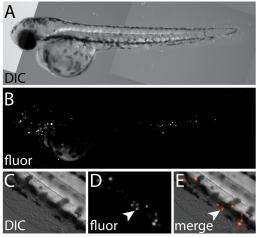Scientists use plasmonic nanobubbles in living organisms to detect, eliminate prostate cancer cells (w/ Video)

(PhysOrg.com) -- Rice University physicist Dmitri Lapotko has demonstrated that plasmonic nanobubbles, generated around gold nanoparticles with a laser pulse, can detect and destroy cancer cells in vivo by creating tiny, shiny vapor bubbles that reveal the cells and selectively explode them.
A paper in the October print edition of the journal Biomaterials details the effect of plasmonic nanobubble theranostics on zebra fish implanted with live human prostate cancer cells, demonstrating the guided ablation of cancer cells in a living organism without damaging the host.
Lapotko and his colleagues developed the concept of cell theranostics to unite three important treatment stages -- diagnosis, therapy and confirmation of the therapeutic action -- into one connected procedure. The unique tunability of plasmonic nanobubbles makes the procedure possible. Their animal model, the zebra fish, is nearly transparent, which makes it ideal for such in vivo research.
The National Institutes of Health has recognized the potential of Lapotko's inspired technique by funding further research that holds tremendous potential for the theranostics of cancer and other diseases at the cellular level. Lapotko's Plasmonic Nanobubble Lab, a joint American-Belarussian laboratory for fundamental and biomedical nanophotonics, has received a grant worth more than $1 million over the next four years to continue developing the technique.
In earlier research in Lapotko's home lab in the National Academy of Sciences of Belarus, plasmonic nanobubbles demonstrated their theranostic potential. In another study on cardiovascular applications, nanobubbles were filmed blasting their way through arterial plaque. The stronger the laser pulse, the more damaging the explosion when the bubbles burst, making the technique highly tunable. The bubbles range in size from 50 nanometers to more than 10 micrometers.
In the zebra-fish study, Lapotko and his collaborators at Rice directed antibody-tagged gold nanoparticles into the implanted cancer cells. A short laser pulse overheated the surface of the nanoparticles and evaporated a very thin volume of the surrounding medium to create small vapor bubbles that expanded and collapsed within nanoseconds; this left cells undamaged but generated a strong optical scattering signal that was bright enough to detect a single cancer cell.
A second, stronger pulse generated larger nanobubbles that exploded (or, as the researchers called it, "mechanically ablated") the target cell without damaging surrounding tissue in the zebra fish. Scattering of the laser light by the second "killer" bubble confirmed the cellular destruction.
That the process is mechanical in nature is key, Lapotko said. The nanobubbles avoid the pitfalls of chemo- or radiative therapy that can damage healthy tissue as well as tumors.
"It's not a particle that kills the cancer cell, but a transient and short event," he said. "We're converting light energy into mechanical energy."
The new grant will allow Lapotko and his collaborators to study the biological effects of plasmonic nanobubbles and then combine their functions into a single sequence that would take a mere microsecond to detect and destroy a cancer cell and confirm the results. "By tuning their size dynamically, we will tune their biological action from noninvasive sensing to localized intracellular drug delivery to selective elimination of specific cells," he said.
"Being a stealth, on-demand probe with tunable function, the plasmonic nanobubble can be applied to all areas of medicine, since the nanobubble mechanism is universal and can be employed for detecting and manipulating specific molecules, or for precise microsurgery."
Lapotko's co-authors on the Biomaterials paper are Daniel Wagner, assistant professor of biochemistry and cell biology; Mary "Cindy" Farach-Carson, associate vice provost for research and professor of biochemistry and cell biology; Jason Hafner, associate professor of physics and astronomy and of chemistry; Nikki Delk, postdoctoral research associate; and Ekaterina Lukianova-Hleb, researcher in the Plasmonic Nanobubble Lab.
More information: The in vivo performance of plasmonic nanobubbles as cell theranostic agents in zebrafish hosting prostate cancer xenografts, Biomaterials, Volume 31, Issue 29, October 2010, Pages 7567-7574. doi:10.1016/j.biomaterials.2010.06.031
Provided by Rice University

















